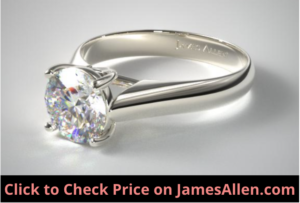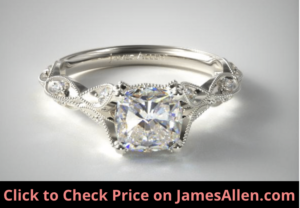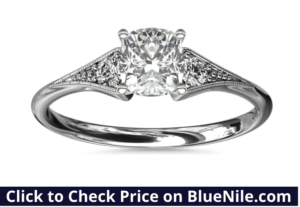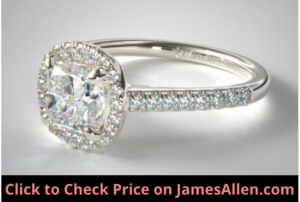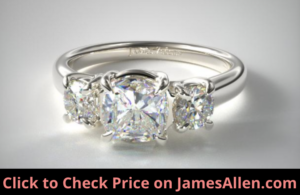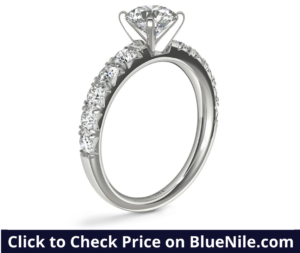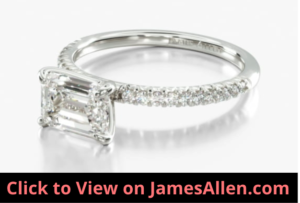
Cushion cut diamonds are a popular choice for engagement rings.
If you’ve found the right one for your ring, the next step is selecting a setting. It can serve as the perfect complement to your ring and showcase your personal style.
Let’s explore the seven best settings for cushion cut diamonds, so you know which is right for you.
1. Solitaire
A solitaire setting is a stunning choice for a cushion cut because it focuses all the attention on the diamond. There are no other gems around it or lining the band.
They’re the most common selection for engagement ring diamonds.
In fact, I chose a solitaire for wife’s engagement ring from James Allen.
Within this category, there are multiple choices.
The cushion cut can be held by a solitaire setting with four or six prongs, and those prongs can be flat or claw-shaped.
For example, this solitaire setting features four claw prongs.
The prongs avoid a simplistic design by crossing over each other as they extend toward the diamond. From the top-down view, it resembles a classic solitaire, but the aesthetic is unique from the profile.
Other solitaire settings for cushion cut diamonds include a cathedral arch.
Check out this stunning example in platinum.
The arch forms two triangular gaps on each side of the diamond.
With a high setting, the diamond captures and reflects more light, which enhances its brilliance.
Another advantage of placing your cushion cut in a solitaire ring is it’s less expensive than one with additional diamonds.
You can put that savings toward a higher carat weight or improved color, cut, or clarity grades.
2. Vintage
Cushion cuts are considered vintage, so it’s fitting to place them in that style of setting.
It resemble those worn during the Art Deco and Victorian eras. It’s important to note that vintage or antique settings aren’t always referring to its actual age.
Jewelers today still create vintage settings.
An identifying characteristic of these rings is the detail.
You’ll often find milgrain, which are small beads of metal, lining the band.
To illustrate, this engagement ring setting has milgrain weaving up the ring as it approaches the diamond.
It surrounds six accents placed inside the ring.
Rotate the image 360 degrees, and examine the detail found in every angle.
In this way, it counters the simple design of a solitaire and instead provides plenty to admire.
The milgrain on this vintage setting is more subtle.
When viewed up close from the top-down, the detail is apparent, but it blends into the design from the profile.
Others feature twisted threads of metal called filigree.
But vintage settings aren’t meant to distract from the cushion cut diamond at its center. Instead, it presents it in an elegant way, where the intricate details complement the diamond.
This is in contrast to bedazzled settings where the main stone is lost among pave diamonds.
I recommend cathedral antique settings for cushion cuts because its arches display the diamond in a prominent position above the ring.
3. Halo
Halo settings are named after the circle of small diamonds that surround the main one.
There are many types of halos for diamond rings. The most popular are single and double halos. Each creates the illusion of a larger center diamond.
This is an effective way to save money on a cushion cut diamond ring because the total carat weight is spread across many gems.
The reason halo settings pair with cushion cuts is because the halo often complements the shape of the main diamond.
Take this halo setting as an example.
Twenty round-cut diamonds surround the cushion cut in the middle. The unique shape of the cushion cut is still visible, but from a distance, it will mimic a round cut.
Another style of halo is a hidden halo.
A belt of diamonds wraps around the top of the ring in a position that’s hidden from the top-down view. It’s only visible from the profile.
Despite its limited visibility, its brilliance increases the apparent size of the diamond by up to 15 percent.
When you add more pave diamonds on the shank, like in this setting you have a brilliant ring that glimmers from every angle.
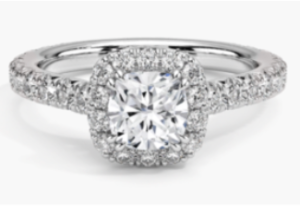
The platinum band matches the colorless cushion cut to create a sleek aesthetic.
4. Three-Stone
Three-stone settings earn their name because there is an additional gem on each side of the main one.
You’ll find versions where the center diamond is larger than the other two, but other times, they’re all the same size.
The reason three-stone settings are an exceptional choice for cushion cut diamonds is because it adds brilliance to the piece.
One of the pros of cushion cuts is strong fire, so this combination produces scintillation when the surrounding diamonds glimmer.
Check out this three-stone diamond ring.
There’s a cushion cut in the middle with a pair of round-cuts. It’s a stunning piece when viewed from the front because all three diamonds are flashing, but rotate the image to learn how it appears at every angle.
One of the most popular designs features tapered baguettes, like this setting. It produces a more subtle glow, because baguette diamonds aren’t known for their light performance.
5. French Pavé
There are many types of pave settings. It refers to small diamonds placed on the ring. They often weigh less than 0.01 carats.
Each style complements cushion cuts in its own way.
French pave settings, also known as “fishtail pave,” include diamonds that sit in V-shaped grooves on the ring. This shape exposes the diamond’s pavilion, which enhances its brilliance.
It contrasts other styles of pave, where the pavilion is blocked by the prong holding it. The prongs are also more visible, so it doesn’t appear like the ring is made of diamonds.
When you’re viewing French pave from a distance, there’s an illusion of a continuous row of diamonds along the band.
To capture the uniqueness of French pave settings for cushion cuts, I’ve posted the example below in the profile view.
Instead of traditional pave diamonds positioned on the ring, notice the V-shaped holes.
Accents enhance the sparkle of a cushion cut diamond ring and pair well with their pillow-like shape.
6. East-West
East-West settings orient the diamond horizontally on the ring. Although they’ve recently gained popularity, it isn’t a new setting.
The difference between this style and the classic one is immediately apparent.
It’s often used for cushion cuts.
For example, here’s an East-West setting.
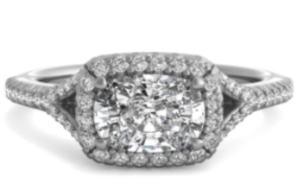
This cushion cut’s rectangular shape is more obvious in this position.
In fact, I recommend choosing this setting for cushion cuts that have higher length to width ratios.
Because East-West settings highlight the horizontal shape of a diamond, it isn’t as effective if the ratio is close to one.
It also has the potential to cause the diamond to appear larger. The way it extends across the width of your finger creates this effect.
The East-West design isn’t exclusive. Combine it with pave, halo, or bezel settings.
This version has petite pave diamonds lining the shank on both sides.
They ascend up the ring to meet the four prongs holding the cushion cut horizontally.
Whether you choose a solitaire variation or one with surrounding diamonds, placing your cushion cut in an East-West setting offers an alternative from traditional designs.
7. Channel
The distinguishing feature of a channel setting is the grooves in the shank that hold small diamonds. At a quick glance, you might think it’s pave because of the way the diamonds are placed along the band.
But if you look closer, you’ll notice they aren’t set on top of the ring but inside of it. A small lip hangs over the edge of those accents to hold them in place.
Here’s an example of a cushion cut with a channel setting in 14K white gold that demonstrates that quality.
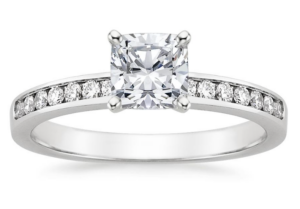
It’s also helpful to view it from the profile, like in this image.
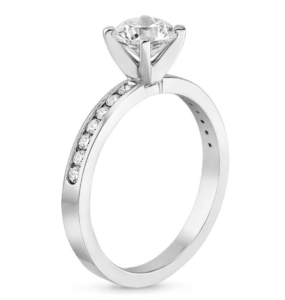
Similar to a pavé setting, it adds some glimmer to the piece to compensate for a cushion cut’s lack of brilliance compared to round.
But because the diamonds are in the groove instead of on top, pavé diamonds generally have stronger light performance. Expect more subtlety with a channel setting.
The most popular version includes round-cut accents to complement the cushion cut, but you can also find them with baguettes.

Jacob Clarke
Jacob Clarke is the founder of TeachJewelry.com.
He earned an Applied Jewelry Professional Diploma from the Gemological Institute of America (GIA) and now brings you essential information about diamonds, settings, and more.
Jacob has consulted with leading jewelry brands, and his work has been cited in Clean Origin, Diamond Nexus and industry publications.
He's also a member of the International Gem Society.
He enjoys discussing jewelry with readers, so contact him with any questions at jacob.clarke@teachjewelry.com.

